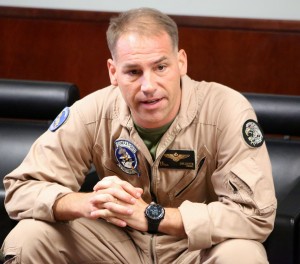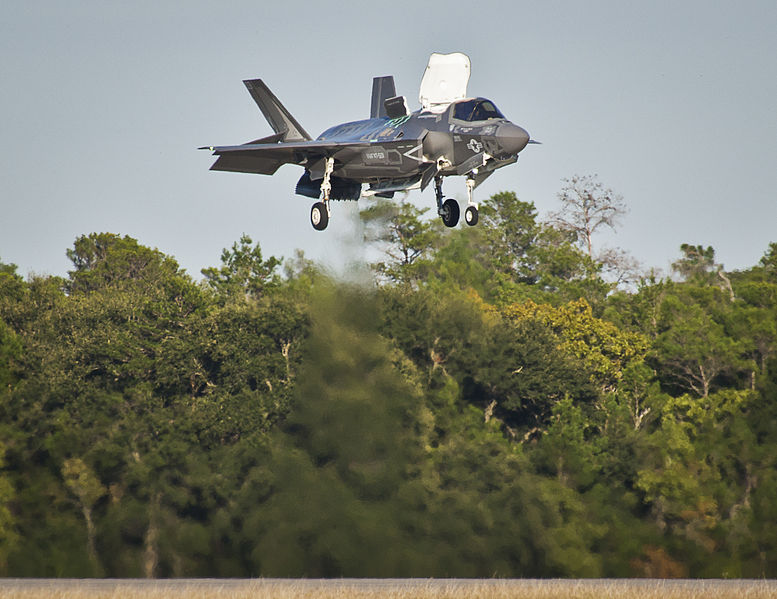Warlords Series 4: Visiting the Ready Room of VMFAT-501, 2013
This article highlights discussions with USMC leaders involved in the F-35 transition for the USMC during our visit in 2013 to the 33rd Fighter Wing at Eglin AFB.
That article published on September 26, 2013 follows:
During the visit of Secretary Wynne to the 33rd Fighter Wing, we accompanied him on the visit and added some meetings of our own.
Among the most notable of those additional meetings was an opportunity to sit down with two USMC leaders in the process of the roll out of the F-35B, namely with Lt. Col. Steve Gillette and Major Michael Rountree of VMFAT501.
Lt. Col. Gillette is currently the X0 of the Squadron and in transition with the jet to Yuma as the CO of Marine Fighter Attack Squadron 121 and then on to Japan with the squadron.
Major Rountree is in charge of maintenance with the squadron and an experienced Harrier operator.
We discussed the roll out of the aircraft from Eglin, to Yuma and then to Japan.

The focus was upon defining what is an initial operational capability squadron and what one can expect from that IOC squadron in Japan and its impact.
We have broken the interview into segments to highlight key elements of the discussion and will then circle back to integrate the parts into a comprehensive piece.
We started with a key point: namely the importance of combat experience to shaping the approach, which the jet will follow as it, is integrated into USMC operations.
The USMC with its experiences in Libya, Iraq and Afghanistan certainly has logged significant understanding of how combat jets are used to support the MAGTF and ground forces overall.
This experience of the past decade is being taken forward into the next and will be an important part of shaping the operational approach for the first decade of the F-35B and its experience with the USMC.
It is also clear that the Osprey and its introduction is part of the legacy being incorporated in the F-35B roll out as well.
Question: We would like to start with an important but basic observation. The warriors are bringing the war to the airplane. The airplane is not going to war for the USMC by itself.
In other words, operational experience precedes the F-35 B and it is being melded into this new piece of equipment.
How do you see it?
Lt. Col. Gillette: That is the right perspective from my point of view. I would say regardless of the airframe, the passion that Marine aviators have in terms of the mission of supporting the infantry is independent of the airframe.
The goal will be is how do you take that desire and passion and then eventually, turn that into the implementation of a new airframe in that role.
Once you move the new airframe piece, and how that fits into the scenario of supporting the infantry will be an evolving process over the next few years.

What I will say is your ability from the air to understand what is going on the ground, only enhances your ability to then make the mission of the Marines on the ground easier.
And with the F-35, the sensors that are onboard and the awareness that we will have as aviators in the cockpit will just continue to be exponentially higher than what is available in current legacy platforms.
Question: What are the key capabilities the aircraft will bring to the mission from the get go?
Lt. Col. Gillette: I would identify two off the bat.
First is what one might call visual acuity. The team will share video across the F-35B operational squadron so that any misunderstanding that comes now from verbal transmissions as a key mode will be reduced significantly.
A second near term benefit is to enhance the ability of every member of the squadron.
The ability of the airplane to ingest information from all different sources, fuse it, will now level the playing field to some extent between the seasoned flight lead, who is doing the communication with the guy on the ground, and the rest of the squadron.
The plane will immediately transmit all the situational awareness built into he plane and provide it to the least experienced member of the flight squadron. And that will happen just like that.
Major Rountree: I have been involved with Harrier and combat operations with the plane for some time.
I would add that the plane we fly now and the plane that was flying with your generation is not the same plane. We have excellent sensors on the plane but they are on the plane and it is up to the pilot to communicate what he sees as a priority.
The pilots are individually managing the data to an outcome, which we set pre-flight and then is executed during the mission. The data remains within the cockpit and is just not being shared.
The pilot is doing all the management, and oh by the way, flying the airplane and as we know the Harrier is not the easiest plane to fly.
Fast-forward to the F-35 B and with the fusion of the data or as the CO Lt. Col. Berke has said the provision of information rather than data, the pilots can re-shape their mission in flight and shift the tasks during the operation.
This is a major change in what a fixed wing aircraft can provide to the MAGTF.
The featured photo shows an F-35B hovering at Eglin AFB, 2013.

